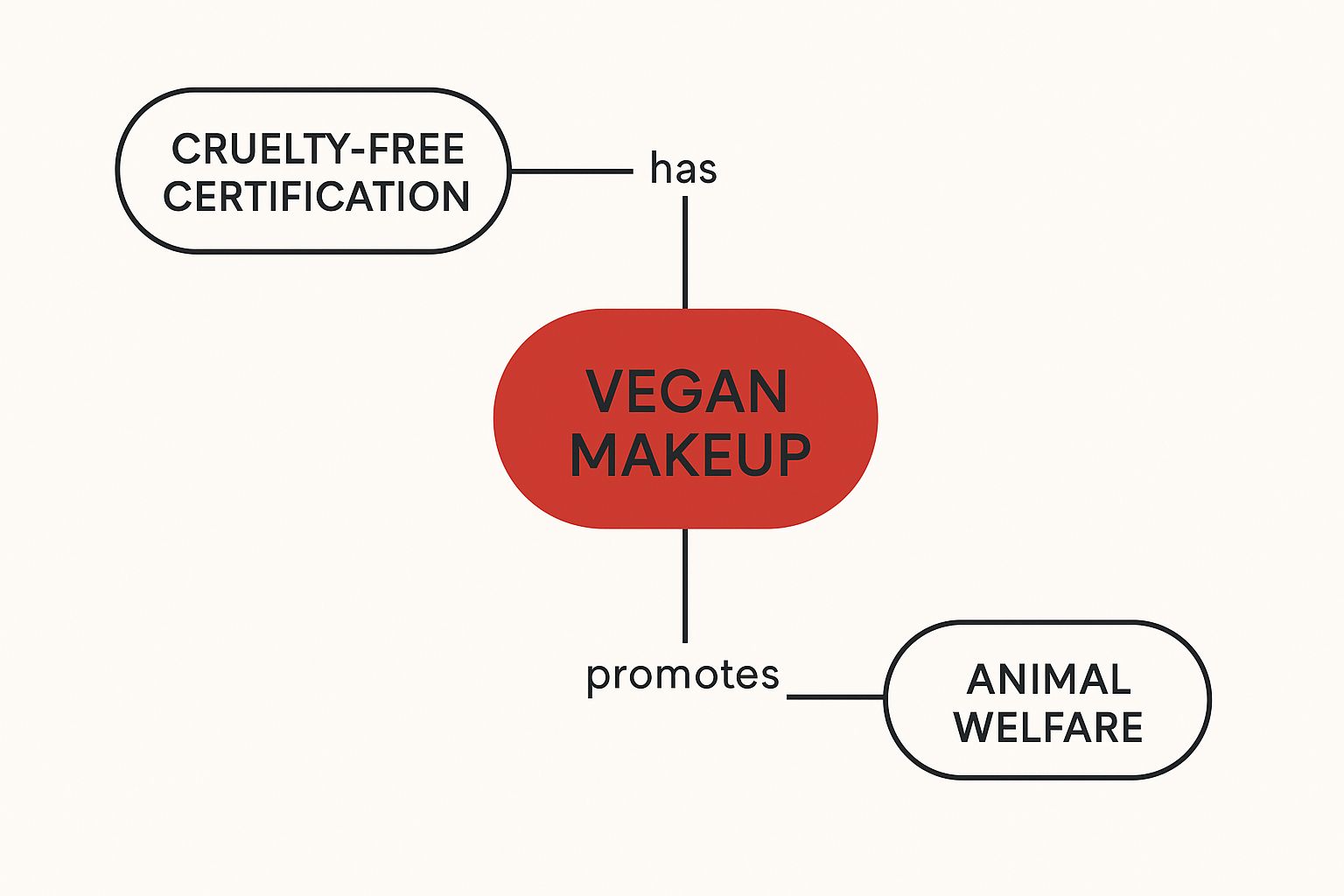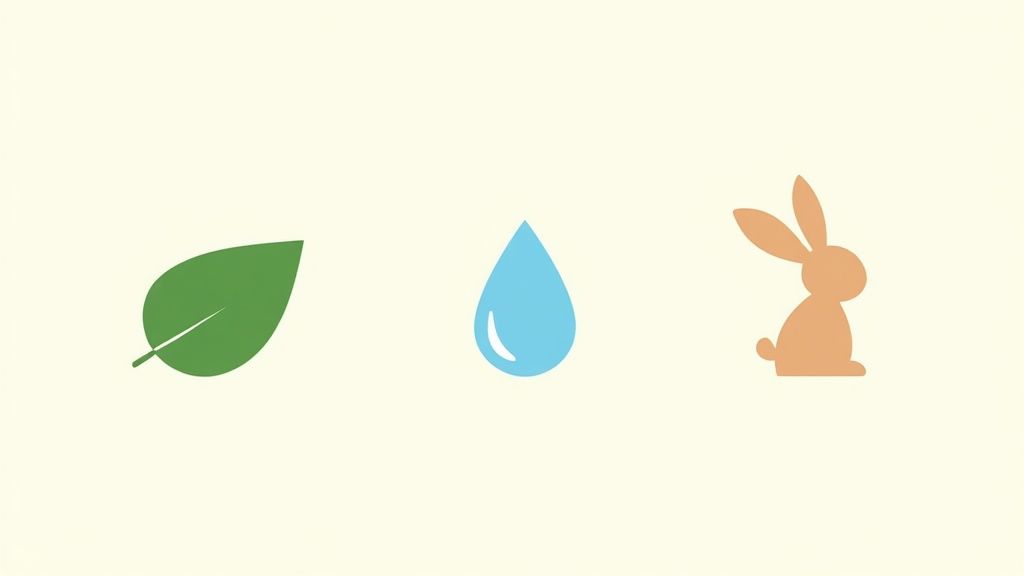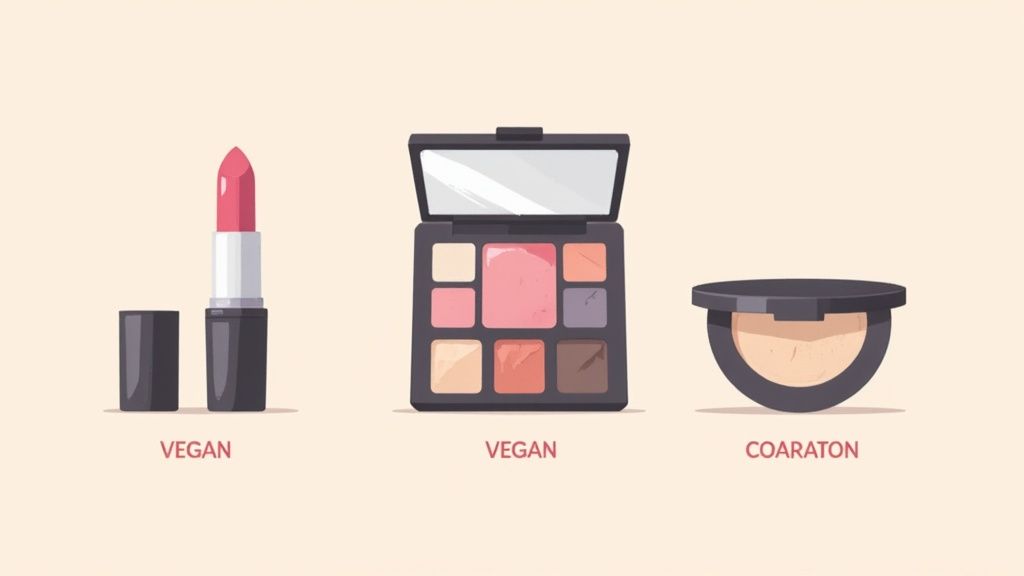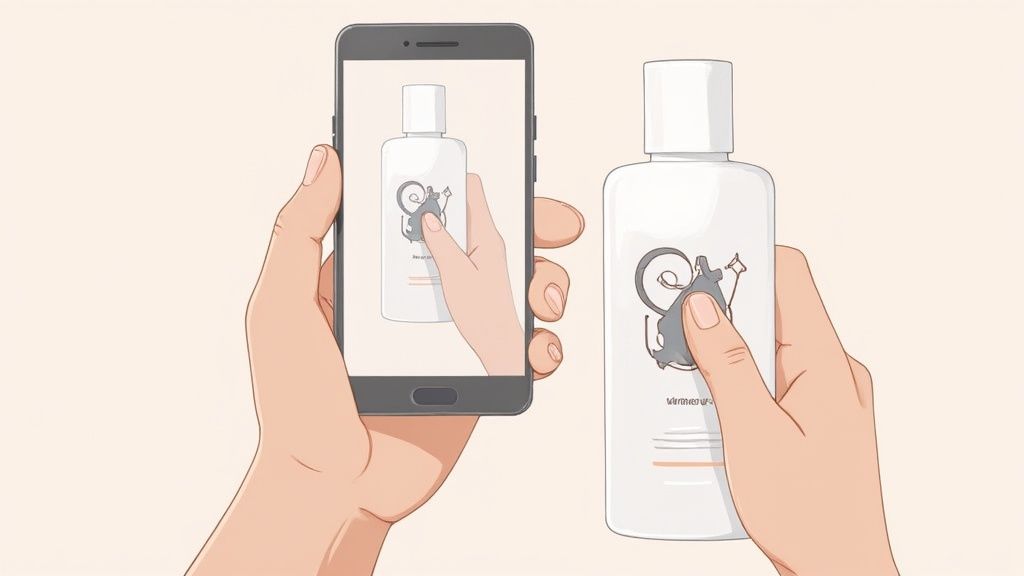So, what exactly is vegan cruelty-free makeup? Put simply, it’s makeup that hits two major ethical benchmarks: it’s made without any animal-derived ingredients, and it’s never tested on animals at any point, from the first ingredient to the final product. It’s the gold standard for anyone who wants their beauty routine to be completely kind to animals.
What Vegan and Cruelty-Free Labels Really Mean
Walking down the beauty aisle can feel like you're trying to crack a code. You’ll see labels like “vegan,” “cruelty-free,” “plant-based,” and “not tested on animals” everywhere, but they definitely don't all mean the same thing. Getting clear on the difference is the first real step toward making conscious choices that actually match your values.
It’s a little like ordering coffee. A “dairy-free” latte avoids cow's milk but might still have honey drizzled on top. A truly “vegan” latte, however, is free of all animal products—no milk, no honey, nothing. That same logic applies to what’s in your makeup bag.
The Two Pillars of Ethical Beauty
Here's where it gets tricky and where a lot of people get confused: a product can easily be one without being the other.
A brand might whip up a gorgeous lipstick using only plant waxes and oils (making it vegan), but then test that lipstick on animals to sell it in countries with those regulations.
On the flip side, another company might proudly announce they've stopped all animal testing (making them cruelty-free), but they still use ingredients like beeswax in their lip balms or carmine—a red pigment made from crushed bugs—in their blushes. That’s why if you’re looking to completely avoid animal exploitation, finding products that are both vegan and cruelty-free is so important.
This map helps visualize how vegan and cruelty-free, while separate paths, both lead to better animal welfare.

As you can see, both paths are distinct but ultimately work toward the same goal of protecting animals in the beauty world.
Let's break down the key differences in a simple chart.
Vegan vs Cruelty-Free Makeup At a Glance
This table clears up the core distinctions between the two labels, helping you understand what each one truly guarantees.
| Attribute | Vegan Makeup | Cruelty-Free Makeup |
|---|---|---|
| Definition | Contains zero animal-derived ingredients or by-products (e.g., beeswax, lanolin, carmine). | The final product and its ingredients were not tested on animals at any stage. |
| Focus | Ingredient composition. | Testing process. |
| Common Certifications | Certified Vegan (Vegan Action) | Leaping Bunny Program, PETA's Beauty Without Bunnies |
| Key Question | What's in the product? | How was the product tested? |
This table shows that while both terms are about animal welfare, they address completely different aspects of production.
Navigating Beyond the Claims
So, how do you know for sure that a product meets these standards? The best way is to look for official certifications from third-party groups. These organizations have super strict processes that go way beyond a brand just saying they’re ethical.
A certification logo is like a passport stamp for your makeup. It proves a brand has gone through an official inspection and meets a strict set of standards, offering a layer of trust that a simple marketing claim cannot provide.
Keep an eye out for these trusted symbols:
- The Leaping Bunny: This is the top-tier certification for cruelty-free, guaranteeing no new animal testing at any phase.
- PETA's Beauty Without Bunnies: This program certifies brands as either "animal test-free" or "animal test-free and vegan."
- Certified Vegan: This logo from Vegan Action confirms a product has no animal ingredients.
This isn’t just a niche trend; it’s a full-blown movement. The global cruelty-free cosmetics market is expected to hit USD 13.2 billion by 2032. This boom is being driven by shoppers like you—especially millennials and Gen Z—who are demanding more honesty and ethical practices from the brands they buy from.
Understanding these basics is everything. To get even deeper into the details, check out our guide on what is vegan makeup and why it's a big deal. When you learn to read the labels and spot the real certifications, you can build a beauty routine that looks good and feels even better.
Hidden Animal Ingredients in Your Makeup Bag

Ever squint at the super long, science-y ingredient list on your favorite lipstick and wonder what’s really in there? It’s a fair question. The truth is, a lot of conventional makeup products are packed with animal-derived ingredients that are anything but obvious.
These sneaky additions often hide behind complicated names, making it tough for even the most dedicated shopper to spot them.
Think of it like being a detective for your diet. You know to avoid the big stuff like milk or eggs, but what about the hidden dairy in your bread or the gelatin lurking in your favorite candy? That same level of vigilance is needed when you're shopping for vegan cruelty free makeup. For centuries, brands have relied on animal byproducts to get just the right colors, textures, and shimmers.
But here’s the good news: modern plant-based science has amazing alternatives for every single one. Knowing what to look for is the secret to making sure your makeup bag is truly, genuinely animal-free.
Common Animal Ingredients to Avoid
Let's pull back the curtain on some of the most common animal-based ingredients that might be hiding in your products. Get familiar with these names, and you'll be able to read labels with confidence and choose products that actually align with your values.
-
Carmine (Cochineal): This one is a big—and pretty gross—culprit. Carmine is a bright red pigment made by crushing thousands of female cochineal beetles. It’s the secret behind the deep reds and pinks in countless lipsticks, blushes, and eyeshadows.
-
Lanolin: This is a greasy substance that comes from sheep's wool. It’s a super common emollient you'll find in lip balms, glosses, and creamy foundations for its moisturizing properties. While the sheep isn't killed for it, its extraction is still tied to the massive wool industry.
-
Guanine: Love that pearly, iridescent glow in your highlighter or eyeshadow? A lot of the time, that shimmer comes from guanine, which is literally scraped from processed fish scales. It creates a crystal-like effect that reflects light.
-
Beeswax (Cera Alba): Produced by bees to build their honeycombs, this ingredient is a go-to thickener in products like mascara, lip balm, and concealer. It helps give products their shape and allows for a smooth application.
By learning to spot just a few key ingredients like carmine and guanine, you can quickly weed out a huge percentage of non-vegan products. It makes the whole shopping experience way faster and less overwhelming.
The Power of Plant-Based Alternatives
Here’s the best part: for every animal-derived ingredient, there’s an incredible, high-performing plant-based alternative. The world of vegan cruelty free makeup isn’t about making sacrifices; it’s about smart innovation. Brands are now using the power of nature to create products that work just as well—if not better—without any compromises.
Take carmine, for example. If you want to go down the rabbit hole, you can get the full story on what cochineal red insect dye is and why so many brands are finally ditching it. Instead of crushed bugs, conscious companies use things like mineral pigments and fruit extracts from beets and berries to create stunningly rich colors.
Here’s a quick rundown of how vegan alternatives easily replace their animal-based counterparts.
| Animal Ingredient | What It Does | Common Vegan Alternative |
|---|---|---|
| Carmine | Provides red pigment | Beetroot, iron oxides, fruit pigments |
| Lanolin | Moisturizes and softens | Shea butter, coconut oil, jojoba oil |
| Guanine | Creates shimmer | Mica, silica, synthetic pearl |
| Beeswax | Thickens and binds | Candelilla wax, carnauba wax, soy wax |
As you can see, you're not losing any of the benefits. Candelilla wax gives a creamy lipstick the perfect structure, and ethically sourced mica can give a highlighter a brilliant, guilt-free glow.
How to Become an Ingredient Detective
Reading labels can feel like a chore at first, but it gets easier with practice, I promise. Just start by focusing on the most common offenders. When you grab a new product, give the ingredient list a quick scan for the names we just covered.
A few practical tips to get you started:
- Look for Vegan Certifications: The simplest shortcut is to look for a "Certified Vegan" logo. This little seal means a third-party organization has already done the homework for you, confirming there are zero animal ingredients inside.
- Use Your Phone: Apps like "Is It Vegan?" can be a lifesaver. You just scan a product’s barcode and get an instant breakdown of its ingredients.
- Know the Aliases: Some ingredients have multiple identities. Carmine, for instance, might show up as "cochineal," "cochineal extract," "crimson lake," "natural red 4," or "C.I. 75470." A quick Google search can help you decode any unfamiliar terms.
Switching to vegan cruelty free makeup is a journey. By arming yourself with a little knowledge, you're doing more than just buying makeup—you're voting for a kinder, more transparent beauty industry.
The Real Impact of Choosing Ethical Beauty

Let's be real: choosing vegan cruelty free makeup is so much more than just a personal preference. It's a statement. Every time you pick up a product that lines up with these values, you’re basically casting a vote for the kind of beauty industry you want to see—one that’s more compassionate and responsible.
It might feel like a small thing, but that one decision sends positive ripples way beyond your own makeup bag. Think of it like supporting your local farmer's market instead of a giant, faceless corporation. Your purchase fuels a system you actually believe in and tells the big players that, hey, we demand better.
Driving Change for Animal Welfare
The most obvious win here is for the animals. When you refuse to buy products tested on animals, you’re helping to cut off the demand that keeps these cruel and outdated practices going. For way too long, animals like rabbits, mice, and guinea pigs have been put through painful tests all for the sake of cosmetics.
Your choice to back cruelty-free brands makes it clear that these methods are no longer profitable. As more and more of us make the switch, corporations have no choice but to listen, adapt, and finally invest in modern, non-animal testing alternatives. This is consumer power in action, and it’s a huge reason why so many countries are now banning cosmetic animal testing.
Every dollar spent on a vegan and cruelty-free product is a clear message to the industry that compassion is not a trend, but a baseline expectation. It shows that beauty should never come at the cost of an animal's well-being.
This isn't just a warm-fuzzy feeling; it’s a massive economic shift. The vegan cosmetics market is on track to hit USD 20.48 billion by 2025. That kind of money talks, proving that kindness is actually great for business.
The Planet-Friendly Perks of Plant-Based Formulas
The good vibes don't stop with animal rights—they extend to the planet, too. The ingredients used in vegan cruelty free makeup tend to have a much smaller ecological footprint. Shocker, right?
Farming plants for things like oils and waxes is just way less intense on resources than factory farming animals for byproducts like lanolin or carmine. Plant-based agriculture usually needs less water, spits out fewer greenhouse gases, and doesn't wreck the land the way large-scale animal operations do.
Just think about it: sourcing shea butter from a tree is a world away from the industrial mess required to get animal fats for a lipstick. These ethical lines are drawn in other industries too, and you can see similar ideas in the principles found in an ethical fashion guide.
A Kinder Choice for Your Skin
Okay, so after all that, the impact comes right back to you and your own skin. Lots of people (myself included) find that vegan formulas are just plain gentler. By kicking common animal-derived ingredients to the curb, vegan makeup often sidesteps potential irritants that can trigger sensitivity, breakouts, and allergic reactions.
Instead, you get ingredients like jojoba oil, shea butter, and fruit extracts. These guys are naturally packed with vitamins, antioxidants, and anti-inflammatory goodies that actually nourish your skin. So when you choose makeup with wholesome, plant-based ingredients, you’re not just making an ethical choice—you’re making a seriously good one for your skin’s health and glow.
How to Find Genuinely Ethical Makeup Brands
So, you’re ready to build a makeup bag that actually reflects your values? Awesome. But trying to navigate the world of ethical beauty can feel a little overwhelming at first. Think of it like learning a new language—once you know a few key phrases and symbols, you can shop with total confidence.
The most reliable shortcut to finding the good stuff is to look for official third-party certifications. These aren't just pretty logos; they're your guarantee that an independent organization has done all the tough investigative work for you. They dig into supply chains and hold brands accountable to super-strict standards, which takes all the guesswork out of it for us.
Decoding the Official Seals of Approval
When you're scanning a product, keep an eye out for these three major players. Their logos are the gold standard for verifying vegan cruelty free makeup and are your best defense against sneaky marketing.
-
The Leaping Bunny: This is the big one—the most rigorous certification for cruelty-free products. To get this logo, a brand has to prove zero animal testing happened at any stage, from the first ingredient to the final tube of lipstick. They also agree to ongoing monitoring to keep their status.
-
PETA's Beauty Without Bunnies: PETA actually offers two different seals: "Animal Test-Free" and "Animal Test-Free and Vegan." That second one is a powerful all-in-one symbol that confirms a product is both 100% vegan and completely cruelty-free.
-
Certified Vegan (Vegan Action): This seal is all about the ingredients. When you see the Vegan Action logo (a "V" inside a heart), you can rest easy knowing the product has absolutely no animal-derived components. For a product to hit that ethical sweet spot, you’ll usually want to see this logo alongside a cruelty-free bunny.
Spotting these certifications is your quickest route to peace of mind. A brand that has gone through the effort to get certified is showing a genuine, transparent commitment to ethical practices, not just paying lip service to a trend.
Avoiding the Trap of Greenwashing
Unfortunately, some brands try to cash in on the conscious consumer trend without actually doing the work. This is called greenwashing, and it involves using vague language or even creating fake logos to seem more ethical than they really are.
Be super skeptical of self-made claims like "Cruelty-Free" or "Not Tested on Animals" if they aren’t backed by one of the official certifications we just talked about. A common trick is for a brand to design its own bunny logo that looks legit but isn't connected to Leaping Bunny or PETA. Always double-check claims on the official online databases of these organizations. It's also helpful to understand why choosing organic skin care products often goes hand-in-hand with cruelty-free values.
The Parent Company Dilemma
Okay, here’s where things can get a little tricky. You might find a brand that is proudly Leaping Bunny certified, but it’s owned by a massive corporation that still conducts animal testing for its other brands. This is a huge and often debated issue in the ethical beauty community.
Whether or not to support these brands is a totally personal call. Some people choose to buy from the cruelty-free brand, seeing it as a vote for ethical practices that shows the parent company what’s profitable. Others prefer to avoid these brands completely, since a slice of the profits ultimately goes to a corporation that still tests on animals.
There’s no right or wrong answer here. It’s all about figuring out your own ethical boundaries and shopping in a way that feels good to you. Trusted blogs and resources can help you untangle these corporate webs so you can make a choice you feel great about.
Thinking Beyond the Formula to Sustainable Packaging

Choosing vegan cruelty free makeup is a massive step in the right direction for a more conscious beauty routine. But let’s be real—the ethics of a product don't stop once the formula is perfect. What happens to that gorgeous tube, jar, or compact after the last swipe?
This is where the next layer of ethical beauty kicks in: sustainable packaging. A truly conscious brand looks at the entire life of its products, from how the ingredients are sourced all the way to making sure the container doesn't end up in a landfill for centuries. The beauty industry has a pretty bad track record with plastic waste, but forward-thinking vegan brands are leading a much-needed shift toward a cleaner, more circular future.
Innovations in Eco-Friendly Packaging
The push away from single-use plastic has sparked some serious creativity in the packaging world. Brands are now embracing materials that are kinder to our planet without sacrificing an ounce of style or performance.
Here are some of the game-changing solutions you’ll see:
- Post-Consumer Recycled (PCR) Materials: This is a fancy way of saying plastic that’s already been used and recycled to create new packaging. It gives existing materials a second life and cuts down on the need to make brand-new plastic.
- Glass and Aluminum: Both are basically infinitely recyclable without losing quality. Plus, they give products that weighty, luxurious feel, proving sustainability can be super chic.
- Refillable Systems: This one is a total game-changer for cutting waste. Instead of buying a whole new product, you just grab a refill pod for your original container. Think of all the packaging you save over time!
- Paper and Bamboo: Brands like Axiology are pioneering the plastic-free movement, using materials like recycled paper that you can easily compost or recycle. You can get the full scoop on these innovations in our deep dive on sustainable cosmetics packaging.
True sustainability in beauty isn't just about what's inside the bottle—it's about ensuring the bottle itself doesn't become part of the problem. It’s a full-circle commitment to the health of our planet.
Making Your Routine More Sustainable
This whole movement for greener packaging is part of a much bigger consumer wave. The sustainable beauty market, which includes vegan cruelty free makeup, was valued at a whopping USD 190.7 billion in 2024 and is projected to hit USD 433.2 billion by 2034. That incredible growth is all thanks to shoppers like you who are demanding cleaner products and more responsible brands.
You can be part of this just by making a few small, but powerful, changes. When you finish a product, take a second to figure out how to dispose of it properly. Check the bottom for recycling symbols or look on the brand's website for specific instructions. Many companies are even partnering with programs to help you recycle those tricky, hard-to-process items.
By thinking beyond the formula, you're helping build a beauty industry that truly cares for our planet. And that’s a beautiful thing.
Got Questions on Vegan Makeup? We’ve Got Answers.
Diving into the world of ethical beauty can feel a little overwhelming. The labels are confusing, you might worry about whether the products actually work, and let's be real, the price tag is always a factor.
Think of this section as your personal cheat sheet. We're here to tackle the most common questions about vegan cruelty free makeup with clear, straightforward answers, so you can feel totally confident in your choices.
If a Product Is Labeled Vegan, Does That Mean It Is Cruelty-Free?
This is probably the biggest point of confusion, and the answer is a hard no, not always. Getting this distinction down is super important for any conscious shopper.
A "vegan" label is all about the ingredients in the product. It’s a guarantee that the formula is totally free of animal-derived stuff like beeswax, lanolin, or carmine.
"Cruelty-free," on the other hand, is about the testing process. It confirms that no animal testing happened at any stage of development. A brand can easily whip up a plant-based foundation but still test it on animals to sell in certain countries. To make sure a product ticks both boxes, you have to look for separate vegan and cruelty-free claims—ideally with a certification logo to back it up.
Is Vegan Cruelty Free Makeup More Expensive?
Thankfully, this is pretty much a myth these days. The idea that you have to shell out more for ethical beauty is totally outdated.
Sure, there are high-end vegan brands, but the market has exploded with amazing options for every budget.
Many affordable drugstore brands now offer top-notch, certified vegan cruelty free makeup that goes head-to-head with the prices of conventional products.
The cost of makeup is now more about brand positioning, ingredient sourcing, and packaging choices than its ethical status alone. You no longer have to pay a premium to align your purchases with your values.
Brands like e.l.f. Cosmetics, Pacifica, and even CoverGirl (which is Leaping Bunny certified!) are proof that compassionate beauty can be accessible to everyone. You can find amazing products without stretching your wallet.
How Can I Tell If a Brand Is Truly Cruelty-Free if Its Parent Company Is Not?
Okay, this one gets a little complicated, and it’s a really personal ethical call. It’s pretty common for a smaller brand to hold onto its cruelty-free certification even after being bought by a huge corporation that still tests on animals for its other brands.
Leaping Bunny will certify these brands, but only if they operate like separate businesses with their own supply chains and meet every single one of the program's strict rules. For example, Urban Decay and IT Cosmetics are both certified cruelty-free, but they're owned by L'Oréal.
So, where do you draw the line?
- Supporting the Brand: Some people buy from the certified brand, seeing it as a vote for cruelty-free. It shows the parent company that this is what customers want.
- Avoiding the Parent Company: Others avoid these brands completely, since a slice of the profit ultimately goes to a corporation that still participates in animal testing.
There’s no "right" answer here. It’s up to you. Websites like Ethical Elephant or Cruelty-Free Kitty are great resources for digging into these corporate family trees so you can make a choice that feels right for you.
Does Vegan Makeup Perform as Well as Traditional Makeup?
One hundred percent, yes. Any performance gap that might have existed in the early days is long gone. Modern cosmetic science and incredible plant-based innovation have completely leveled the playing field.
Today’s vegan cruelty free makeup delivers amazing color payoff, long-lasting wear, and gorgeous textures that often blow their non-vegan counterparts out of the water. Brands are pouring tons of research into developing high-performance alternatives, from buttery foundations to vibrant lip colors that just don't quit. You never have to sacrifice quality for your ethics.
Ready to build a beauty routine that feels as good as it looks? At Axiology, we believe in makeup that's kind to animals, the planet, and your skin. Explore our collection of 100% vegan, cruelty-free, and plastic-free products to discover the future of conscious beauty. Shop Axiology now.





